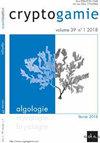Structural and Functional Genes, and Highly Repetitive Sequences Commonly Used in the Phylogeny and Species Concept of the Phylum Cyanobacteria
IF 1.5
4区 生物学
Q3 MARINE & FRESHWATER BIOLOGY
引用次数: 0
Abstract
ABSTRACT Cyanobacteria are a lineage of Eubacteria that have long captured the attention of scientists. Approximately 5310 species of cyanobacteria have been hitherto described and new species are continually being found, named and described according to established rules. The correct determination of cyanobacteria strains concerns new biotechnological applications as well as ecological studies. There are many situations where it is crucial to recognise distinct algae species, however methods for doing so vary greatly. The aim of this review is to summarize the state of the art of the main and most recent molecular studies focusing on the phylum Cyanobacteria, with particular attention to the most frequently used gene markers. For a long time, the classification method used for cyanobacteria as well as traditionally described species was mainly based on morphology. Over time, integrative taxonomy, which involves the inclusion of many characters and comprehensive taxa sampling, has become the rule as it provides a better resolution of species relationships. For a better resolution of the phylogenies of the phylum Cyanobacteria, it is usually necessary to focus on different genetic markers: from the most common, like the 16S and 23S rRNA, ITS, rbcLXS and rpoC genes, to genes not so widely used, such as hetR, psbA, tufA, gyp and cpcBA. Also, the highly repetitive sequences often used for the symbiotic cyanobacteria represent an important factor in the inference of the phylogenetic relationships. RÉSUMÉ Gènes structurels, fonctionnels, et séquences hautement répétitives couramment utilisés pour la phylogénie et concept d'espèces dans le phylum des cyanobactéries. Les cyanobactéries sont une lignée d'eubactéries qui attirent depuis longtemps l'attention des scientifiques. Environ 5 310 espèces de cyanobactéries ont été décrites jusqu'à présent et de nouvelles espèces sont continuellement découvertes, généralement nommées et décrites d'après des règles précises. La détermination correcte des souches de cyanobactéries a des répercussions sur de nouvelles applications biotechnologiques ainsi que sur des études écologiques. Dans de nombreuses situations, il est crucial de reconnaître des espèces d'algues distinctes, mais les méthodes pour y parvenir varient considérablement. L'objectif de cette revue est de faire le point sur les principales et les plus récentes études moléculaires portant sur le phylum des cyanobactéries, en accordant une attention particulière aux marqueurs génétiques les plus fréquemment utilisés. Pendant longtemps, la méthode de classification utilisée pour les cyanobactéries et les espèces traditionnellement décrites était principalement basée sur la morphologie. Au fil du temps, la taxonomie intégrative, qui implique l'inclusion de nombreux caractères et un échantillonnage complet des taxons, est devenue la règle car elle permet une meilleure résolution des relations entre espèces. Pour une meilleure résolution des phylogénies du phylum des cyanobactéries, il est généralement nécessaire de se concentrer sur différents marqueurs génétiques: des plus courants, comme les gènes ARNr 16S et 23S, ITS, rbcLXS et rpoC, aux gènes moins utilisés, comme hetR, psbA, tufA, gyp et cpcBA. De plus, les séquences hautement répétitives souvent utilisées pour les cyanobactéries symbiotiques représentent un facteur important dans la construction des relations phylogénétiques.蓝藻门系统发育和物种概念中常用的结构和功能基因以及高度重复序列
蓝藻是真细菌的一个谱系,长期以来一直引起科学家的注意。迄今为止,已经描述了大约5310种蓝藻,并且不断发现新物种,根据既定规则命名和描述。蓝藻菌株的正确测定涉及新的生物技术应用以及生态研究。在许多情况下,识别不同的藻类物种是至关重要的,然而,这样做的方法差别很大。本综述的目的是总结目前的主要和最新的分子研究集中在门蓝藻,特别注意最常用的基因标记的艺术状态。长期以来,蓝藻以及传统上描述的物种的分类方法主要基于形态学。随着时间的推移,包括许多特征和综合分类群抽样的综合分类学已经成为一种规则,因为它提供了更好的物种关系解决方案。为了更好地解决蓝藻门的系统发育问题,通常有必要关注不同的遗传标记:从最常见的16S和23S rRNA、ITS、rbcLXS和rpoC基因,到不那么广泛使用的基因,如hetR、psbA、tufA、gyp和cpcBA。此外,共生蓝藻经常使用的高度重复序列是推断系统发育关系的重要因素。RÉSUMÉ 结构、功能、薪金、薪金、薪金、薪金、薪金、薪金、薪金、薪金、薪金、薪金、薪金、薪金、薪金、薪金、薪金、薪金、薪金、薪金、薪金、薪金、薪金、薪金、薪金、薪金和薪金。蓝藻变异体引起了科学家们的长期关注,而蓝藻变异体引起了科学家的长期关注。环境5 310电子表格中有蓝色的电子表格,有蓝色的电子表格,有蓝色的电子表格,有蓝色的电子表格,有蓝色的电子表格,有蓝色的电子表格,有蓝色的电子表格,有蓝色的电子表格。在生物技术的新应用中,利用生物技术的方法,利用生物技术的方法,利用生物技术的方法,利用生物技术的方法,利用生物技术的方法,利用生物技术的方法,利用生物技术的方法,利用生物技术的方法,利用生物技术的方法,使生物技术的方法得到改进。在不同的情况下,最重要的是要重新确定《公约》所规定的不同的、不同的、不相同的、不相同的、不一致的、不一致的、不一致的、不一致的、不一致的、不一致的、不一致的、不一致的、不一致的和不一致的。根据特别注意事项,我们的目标是确定这些原则点,并将这些原则点与其他原则点结合起来,将这些原则点与其他原则点结合起来,将这些原则点与其他原则点结合起来,将这些原则点与其他原则点结合起来,将这些原则点与其他原则点结合起来,将这些原则点与其他原则点结合起来。在长时间的分类中,分类利用的是:蓝藻- - - - - - - - - - - - - - - - - - - - - - - - - - - - - - - - - - - - - - - - - - - - - - - - - - - - - - - - - - - - - - -简单地说,在所有的分类中都包含了所有的分类,在所有的分类中都包含了所有的分类,在所有的分类中都包含了所有的分类,在所有的分类中都包含了所有的分类。1 .将不同种类的蓝细菌-蓝细菌-蓝细菌-蓝细菌-蓝细菌-蓝细菌-蓝细菌-蓝细菌-蓝细菌-蓝细菌-蓝细菌-蓝细菌-蓝细菌-蓝细菌-蓝细菌-蓝细菌-蓝细菌-蓝细菌-蓝细菌-蓝细菌-蓝细菌-蓝细菌-蓝细菌-蓝细菌-蓝细菌-蓝细菌-蓝细菌-蓝细菌-蓝细菌-蓝细菌-蓝细菌-蓝细菌-蓝细菌-蓝细菌另外,在系统关系的构建中,有重要的因素,如系统关系的构建、系统关系的构建、系统关系的构建、系统关系的构建等。
本文章由计算机程序翻译,如有差异,请以英文原文为准。
求助全文
约1分钟内获得全文
求助全文
来源期刊

Cryptogamie Algologie
生物-海洋与淡水生物学
CiteScore
2.60
自引率
7.70%
发文量
11
审稿时长
>12 weeks
期刊介绍:
Cryptogamie is a fast-track and peer-reviewed journal of international scope publishing in English only. It accepts original papers and review articles on the taxonomy, biology and ecology of all cryptogams. An issue of Cryptogamie may be devoted to a single topic, under the responsibility of guest editor(s). All articles published in Cryptogamie are compliant with the different nomenclatural codes. A copyright assignment will be signed by the authors before publication.
Cryptogamie, Algologie accepts articles on systematics as well as ecology and evolution of any kind of algae (including Cyanobacteria).
 求助内容:
求助内容: 应助结果提醒方式:
应助结果提醒方式:


